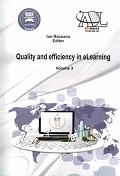BLENDED LEARNING TEXTILE CHEMISTRY USING MOODLE VIRTUAL LEARNING ENVIRONMENT
BLENDED LEARNING TEXTILE CHEMISTRY USING MOODLE VIRTUAL LEARNING ENVIRONMENT
Author(s): Aurelia Grigoriu, Paula Dughilă, Adrian AddăscăliţeiSubject(s): Education
Published by: Carol I National Defence University Publishing House
Keywords: elearning interactive training modules; chemical textile engineering curricula; doctoral research; moodle
Summary/Abstract: Blended Learning courses combine face-to-face (traditional) and online learning. This method of learning is for students who do not want to miss out on the traditional classroom experience, but want the flexibility essential with online learning. All blended courses will meet the first day of class and at least three other face-to-face meetings. Textile chemistry can generally be divided into three major areas: dyeing and finishing chemistry, fiber and polymer chemistry, and a newer area that intersects with materials science and involves the blending of textile materials. Online e-learning has also undergone a revolution wherein virtually all universities have provided courses that can be taken asynchronously, anywhere and at anytime. Tools and technologies have rapidly evolved to transform the conventional sequential unidirectional methods into collaborative omni directional learning environments. Piaget’s theory of cognitive development stated that “the learner must be active; he is not a vessel to be filled with facts. Learning involves the participation of the learner”. eBooks and new collaborative learning software allows us to create materials and an environment that allow students to explore and independently navigate tendrils of interconnecting concepts that will empower and enhance their construction of a more cohesive understanding of interconnected facets of a discipline. Students are rarely prompted to construct explanations of scientific phenomena for themselves. In many undergraduate courses, students spend a great deal of time either passively listening to lecturers’ explanations or reading explanations from textbooks. Moreover, textbook explanations are often presented succinctly and in rapid succession, as if the material is straightforward and requires nothing more than memorization. Classroom activities that facilitate students generating their own explanations (i.e., developing and deploying explanatory knowledge) can therefore be powerful conceptual teaching and learning tools. Active learning strategies such as cooperative learning groups, guided inquiry, and peer-led team learning demonstrate progress toward student production of explanations in the undergraduate chemistry classroom. This paper presents the design principles and implementation of interactive training modules from chemical textile engineering curricula performed on ” http://www.moodle.tex.tuiasi.ro/” elearning platform. Modules can be used also in traditional didactic activity: course lectures, laboratory, seminar and / or design classes. Interactive simulations allow learning of: knowledge, skills and abilities, necessary to engineering students in their future professional activity. Elearning modules aimed mainly effective interaction between student and content. Interactive graphical interface helps the student to understand quickly and accurately the issues of the course content and enables simulation of real industrial processes.
Journal: Conference proceedings of »eLearning and Software for Education« (eLSE)
- Issue Year: 9/2013
- Issue No: 03
- Page Range: 350-355
- Page Count: 6
- Language: English

